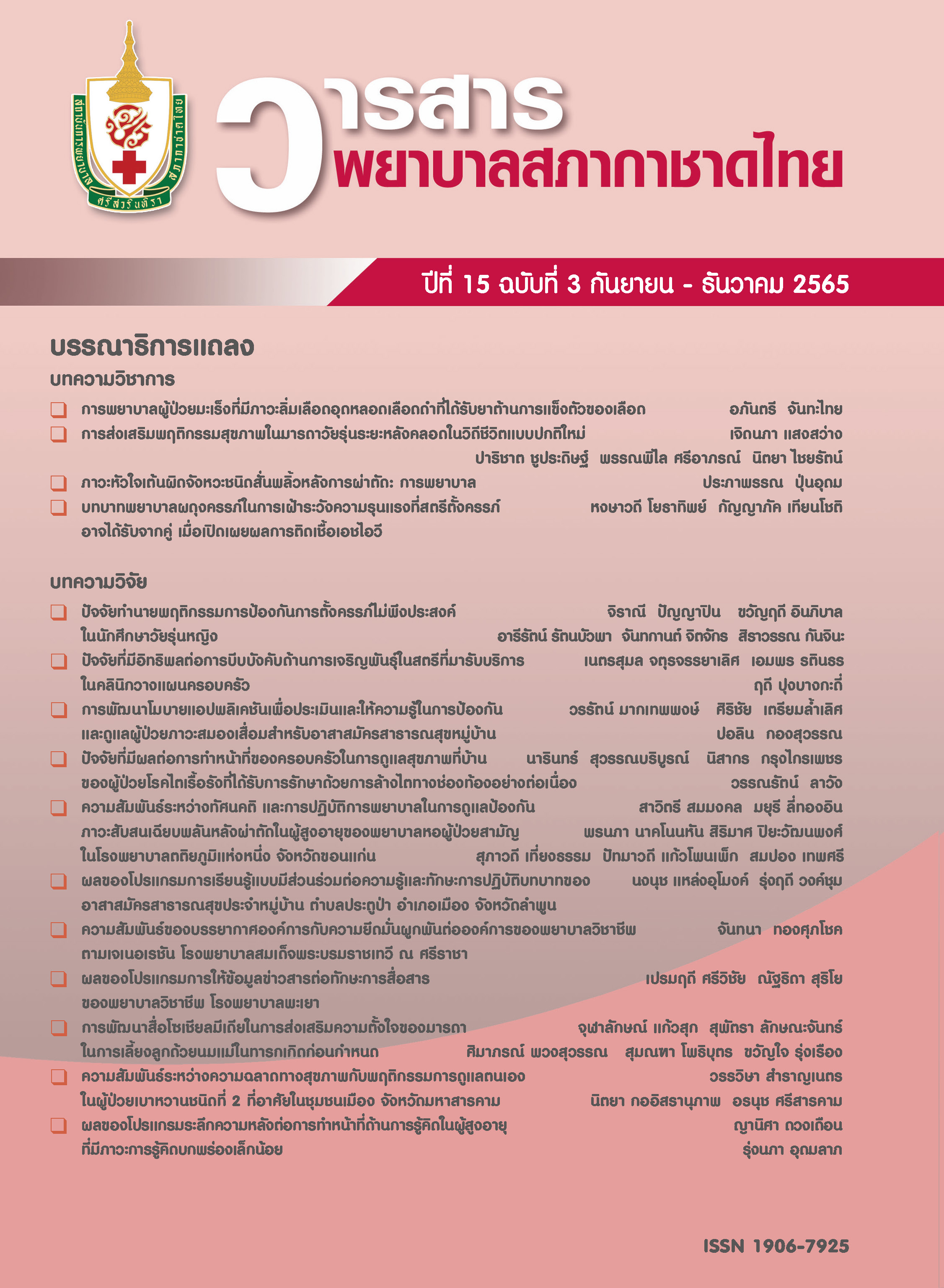Factors Predicting Unwanted Pregnancy Prevention Behavior Among Female Adolescent Students
Keywords:
unwanted pregnancy prevention behavior, sexual health literacy, risk actions of social hazards, adolescent studentAbstract
This predictive study aimed to explore the factors predicting unwanted pregnancy prevention behaviors among female adolescents. The research subjects consisted of 374 female students studying in the first academic year 2020 in Northern University, Thailand. A simple random sampling technique was used to collect the data. The self-administered online questionnaires used for the study included a demographic questionnaire, a risk actions of social hazards questionnaire, a health literacy questionnaire related to preventing pregnancy, and an unwanted pregnancy prevention behaviors questionnaire for teenage Thai women. Data were analyzed using descriptive statistics, Pearson correlation coefficient, and stepwise multiple regression analysis.
The results revealed that overall sexual health literacy factors were positively correlated with unwanted pregnancy prevention behavior among female adolescent students (rs = .245, p < .01). Factors significantly predicting unwanted pregnancy prevention behaviors were risk actions of social hazards (β = -.446, p < .01), making the right decisions to prevent unwanted pregnancy (β = .144, p < .01), and health comprehension (β = .091, p < .05). Interestingly, all these factors accounted for 38.5 percent of the prediction value of unwanted pregnancy prevention behaviors (R2 = .385, p < .01)
In conclusion, the factors preventing unwanted pregnancies among female adolescent students include reducing the risk actions of social hazards, promoting the right decisions for preventing unwanted pregnancy, and enhancing overall knowledge and health comprehension.
References
Bureau of Reproductive Health. Situation of adolescent pregnancy 2019 [Internet]. n.d. [cited 2020 May 2]. Available from: https://rh.anamai.moph.go.th/th/department-yearly-report/download/?did=193341&id=42521&reload=(in Thai)
Bureau of Reproductive Health. Situation of adolescent pregnancy 2020. [Internet]. n.d. [cited 2020 Oct 21]. Available from: https://rh.anamai.moph.go.th/web-upload/7x02700 6c2abe84e89b5c85b44a692da94/202101/m_news/32053/200929/file_download/549 9b750564075b590cc442f64caae41.pdf (in Thai)
Bureau of Reproductive Health. Adolescent pregnancy: policy implementation and evaluation. 4th ed. Nonthaburi: The Agricultural Cooperative Federation of Thailand; 2016. (in Thai)
Srisuriyawet R, Homsin P. Mother-daughter sexual risk communication and psychosocial factors related to sexual experience among female students. The Public Health Journal of Burapha University 2014;9(2):33-44. (in Thai)
Tripathi S. Life assets of Thai children and youth. 8th ed. Bangkok: October Print; 2013. (in Thai)
Intarakamhang U, Khumthong T. Measurement development of health literacy and unwanted pregnancy prevention behavior for Thai female adolescents. Journal of Public Health Nursing 2017;31(3):19-37. (in Thai)
Sakulwaleethorn U, Sananreangsak S, Teerarungsikul N. Predictors of preventing sexual risk behaviors among female teenagers studying in lower secondary school. EAU Heritage Journal Science and Technology 2018;12(2):253-64. (in Thai)
Shrestha S. Socio-cultural factors influencing adolescent pregnancy in rural Nepal. Int J Adolesc Med Health 2002;14(2):101-9.
Houwma N. Health literacy on unwanted pregnancy prevention for female students in the Faculty of Education, Yala Rajabhat University [Internet]. 2018 [cited 2020 May 2]. Available from: http://wb.yru.ac.th/xmlui/handle/yru/5051 (in Thai)
Manganello JA. Health literacy and adolescents: a framework and agenda for future research. Health Educ Res 2008;23(5):840-7.
Krejcie RV, Morgan DW. Determining sample sizes for research activities. Educ Psychol Meas 1970;30:607-10.
Bloom B. Learning for Master Evaluation Comment. Center for the Student of Evaluation of Instruction Program. University of California, Los Angeles; 1968.
Ngomsangad Y, Srisuriyawet R, Homsin P. Factors influencing health literacy related pregnancy prevention among female adolescent students in Si Sa Ket Province. The Public Health Journal of Burapha University 2019;14(2):38-51. (in Thai)
Tangnorakul P, Sananreangsak S, Teerarungsikul N. The relationship between sexual health literacy and sexual behavior among middle school female students. Royal Thai Navy Medical Journal 2019;46(3):607-20. (in Thai)
Kaewviengdach C, Hirunwatthanakul P. Factors associated with sexual risk behaviours among secondary school students in Nakhon Phanom Province. J Royal Thai Army Nurses 2016;17(3):168-77. (in Thai)
Liu C, Wang D, Liu C, Jiang J, Wang X, Chen H, et al. What is the meaning of health literacy? A systematic review and qualitative synthesis.Fam Med Community Health 2020;8(2):e000351. doi:10.1136/fmch-2020-000351
Srijaiwong S, Sindhu S, Ratinthorn A, Viwatwongkasem C. Factors influencing sexual behaviors among Thai adolescents. Journal of Population and Social Studies 2017;25(3):171-93.
Lertsakornsiri M. Factors associated with unwanted adolescent women pregnancy in the perceived of the first year students at Saint Louis College. J Royal Thai Army Nurses 2014;15(1):90-8. (in Thai)
Dongarwar D, Salihu HM. Influence of sexual and reproductive health literacy on single and recurrent adolescent pregnancy in Latin America. J Pediatr Adolesc Gynecol 2019;32(5):506-13. doi: 10.1016/j.jpag.2019.06.003
Downloads
Published
Issue
Section
License
Copyright (c) 2023 Srisavarindhira Thai Red Cross Institute of Nursing

This work is licensed under a Creative Commons Attribution-NonCommercial-NoDerivatives 4.0 International License.
เนื้อหาบทความหรือข้อคิดเห็นต่างๆ ในวารสารพยาบาลสภากาชาดไทยนี้ เป็นความคิดเห็นของผู้เขียนบทความ ไม่ใช่ความเห็นของกองบรรณาธิการ หรือสถาบันการพยาบาลศรีสวรินทิรา สภากาชาดไทย






